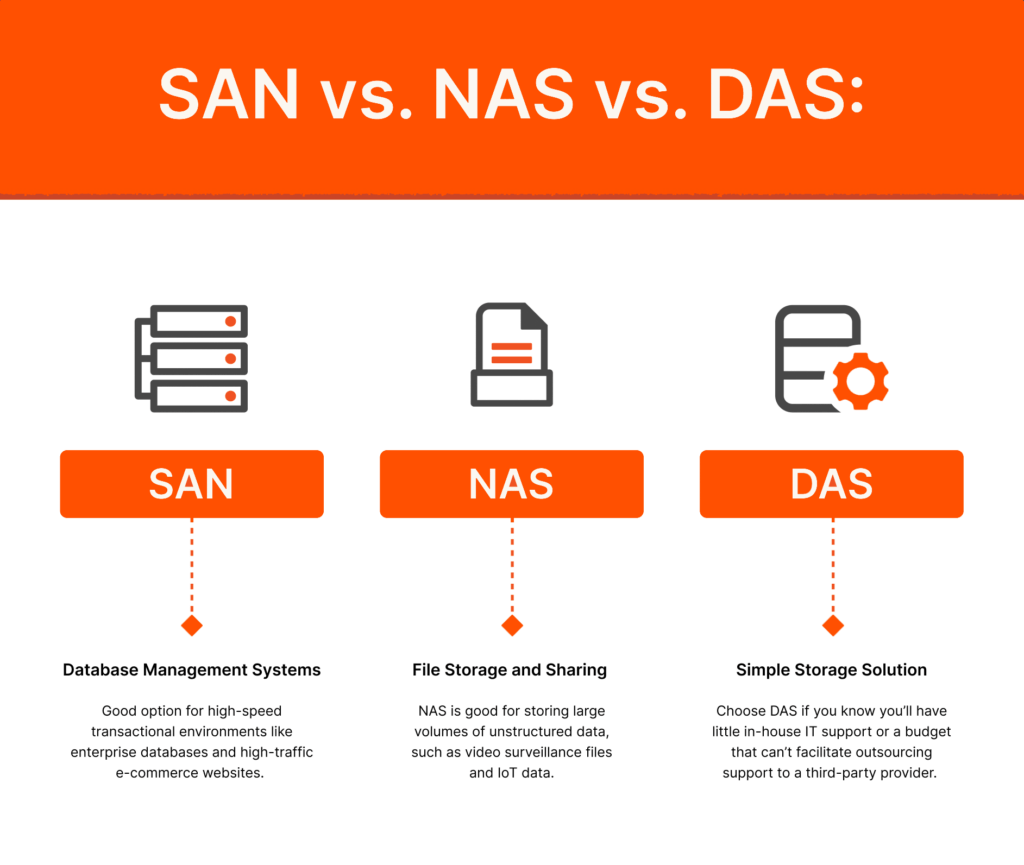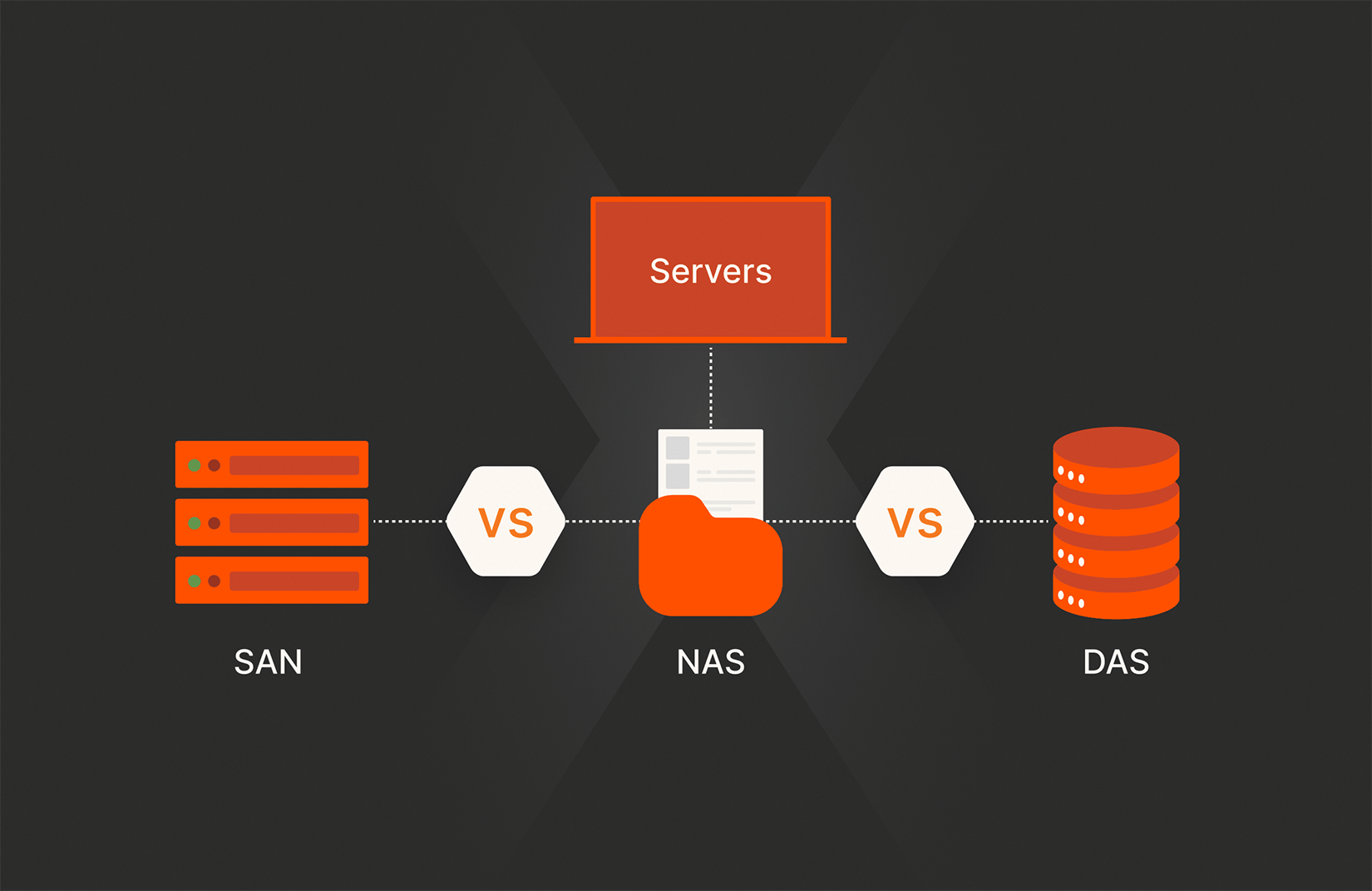Deciding on the right storage system can be a complex decision, as it needs to balance costs, storage capacity needs, and scalability requirements. The three primary options for enterprise data storage systems are direct-attached storage (DAS), network-attached storage (NAS), and storage area networks (SANs). Each offers advantages and disadvantages for organizations.

Where Do You Use SAN?
Database Management Systems
SAN’s high I/O processing speeds and low latency make it a good option for high-speed transactional environments like enterprise databases and high-traffic e-commerce websites.
Databases often support mission-critical workloads that process large amounts of transactional data and might need to handle hundreds of thousands of transactions per second. This requires reliable, scalable storage that can deliver high input/output operations per second (IOPS) and low latency rates.
Virtualization
Virtualized environments require large-scale and high-performance deployments and often comprise thousands of virtual machines (VMs) running a wide range of operating systems and applications. SANs can quickly transfer multiple I/O streams between VMs and virtualization hosts, making them better suited than NAS for virtualized environments.
Non-disruptive DR Drills for Oracle Databases Using Pure Storage ActiveDR
Where Do You Use NAS?
File Storage and Sharing
NAS is commonly used in organizations of all sizes for centralized file storage and sharing. Combining multiple files servers onto one NAS device supports collaboration, saves space, and creates greater simplicity and ease of management.
Big Data
NAS is good for storing large volumes of unstructured data, such as video surveillance files and IoT data. Scaled-out NAS is often used for ETL (extract, transform, load) operations and for processing intelligent data services and big data analytics.
Where Do You Use DAS?
Budget Constraints
As a small or medium-sized business, your budget might not have room for a high-performance storage solution like SAN or NAS, which can cost hundreds of thousands of dollars. A DAS system is practical and cost-effective if you don’t have the budget for advanced storage solutions but still need a lot of storage.
A Simple Storage Solution
Since DAS doesn’t connect to the network, it’s more suitable for smaller organizations that share data locally, rather than across an extensive network. DAS is easy to set up on individual computers requiring only the storage device and any optional drive enclosures.
Choose DAS if you know you’ll have little in-house IT support or a budget that can’t facilitate outsourcing support to a third-party provider.
Why Open-source Databases Need Modern Storage
NAS vs. SAN vs. DAS: What Are the Differences?
The major differences between DAS, NAS, and SAN are costs, scalability, and how storage is shared. The three systems also use different storage mechanisms: DAS primarily uses hard-drive storage with sectors, NAS uses shared files, and SAN uses block storage.
Different technologies are also used for transmitting data. DAS uses IDE/SCSI, NAS uses TCP/IP and Ethernet, and SAN uses Fibre Channel and IP.
Keep up with the latest innovations to the Pure Storage platform.
NAS vs. SAN vs. DAS: What Are the Advantages?
What Are the Advantages of SAN?
- Improved performance: A SAN offers increased performance over DAS and NAS because storage processing is done on a network separate from the local area network (LAN). Moving storage tasks to a dedicated SAN ensures that performance on the SAN isn’t affected by traffic congestion on the LAN. It also removes storage traffic from the LAN to free up bandwidth and improve performance.
- Greater scalability: A SAN can comprise thousands of SAN storage devices and host servers that can be scaled to meet evolving business needs. Organizations can add new hosts and storage devices to build out the SAN when capacity needs increase.
- Improved availability: SAN storage is accessible through multiple paths and remains independent of the applications it supports. The SAN network fabric can use alternative paths to maintain storage availability if a communication failure occurs, ensuring that there’s no single point of failure between the host and the storage device.
What Are the Advantages of NAS?
- Scalability: NAS allows organizations to scale storage capacity without replacing or upgrading existing servers or shutting down the network. Storage can be easily increased by adding another NAS device, another hard drive, or a hard drive with greater capacity.
- Greater accessibility: NAS creates a centralized storage system that makes it easier for networked devices to access data. Users can collaborate and share files from multiple locations whether they’re using a PC or a Mac or using different operating systems such as Windows, Unix, or Mac OS.
- Performance: While NAS performance levels aren’t as high as SAN systems, these systems still offer some performance benefits. Since NAS removes file serving responsibilities from other networked devices and is connected to the LAN, it can store and serve files more quickly, contributing to increased performance.
What Are the Advantages of DAS?
- Easy setup: Both internal and external DAS solutions are simple to set up, configure, and access. Internal direct-attached storage comes preinstalled in a new computer or server and can be used immediately. Plug-and-play external storage can be used as soon as it’s attached by a USB port.
- Low cost: Unlike NAS and SAN, DAS requires no hardware or software to run and manage the storage system, making it a very affordable option when compared to NAS and SAN which require hardware and software to run and manage the storage system. To set up a DAS system, your only costs are those associated with the disk drives and any drive enclosures you need.
- High performance: Because storage is directly connected to the DAS host machine, DAS can provide fast access to data and support high-performance I/O operations. And, because it isn’t connected to the network, a DAS system isn’t affected by bandwidth issues or network latency.
NAS vs. SAN vs. DAS: What Are the Disadvantages?
What Are the Disadvantages of SAN?
- Costs: The cost of setting up and maintaining the fibre infrastructure to support a SAN can be significant. Redundant, high-performance storage is costly, and it can take some time before you see a return on investment. SAN also requires ongoing maintenance and management, incurring additional costs. This makes SANs better suited for larger organizations that can afford to invest the initial capital costs.
- More complicated to set up and maintain: The complexity of SANs can require specific expertise to manage and maintain. As a result, you’ll likely need to maintain trained in-house IT personnel to support the SAN or to outsource support to a third-party provider.
What Are the Disadvantages of NAS?
- Increases LAN traffic: Heavy use of the NAS can increase network traffic and cause congestion on the LAN, affecting other users. This makes NAS unsuitable for applications that perform intensive data transfer operations.
- Performance limitations: NAS is limited by the bandwidth of the enterprise network, and its SMB and NFS (Network File System) protocols aren’t fast enough to support high-performance applications. As more clients join the network and access the NAS file system, performance can degrade to unsuitable levels. This makes NAS better suited for smaller networks.
- Security and reliability: NAS can’t be configured for high availability, increasing the likelihood that it can become a single point of failure as the network grows. Since the NAS only provides on-site data backup, both the NAS and business data can be lost if a natural event, cyberattack, or human error occurs.
What Are the Disadvantages of DAS?
- Limited accessibility: Direct-attached storage is only accessible to applications running on the computer or server that the DAS is connected to. Since it doesn’t use network hardware to share storage resources, storage isn’t accessible to other user groups on the network, which can impact productivity and collaboration.
- Limited scalability: DAS can be difficult to scale because options are limited to the number of internal drive bays, the capacity of external DAS devices, and the availability of external ports on individual devices.
- No central management and backup: DAS provides no mechanisms for central management and backups. This is less of a problem when only a few computers use DAS, but making sure that DAS storage is available and protected can become more expensive and complex as the enterprise network grows.
Which Is Better: NAS vs. SAN vs. DAS?
DAS, NAS, and SAN all offer benefits, but how meaningful they are for your organization will depend on your needs. Ultimately, the best solution for you will come down to the amount of storage capacity you need, your budget, and your backup and disaster recovery requirements.
Will you need to add storage capacity in the near future? How many employees need to access storage at the same time? Will they need remote access? Do you have the IT resources to manage the chosen storage system? These are just some of the questions you’ll need to answer when choosing between NAS, SAN, and DAS.
If you’re a small business with limited financial and IT resources, DAS is likely your best option. But if you’re moving to a NAS or SAN solution for greater performance and higher storage capacity, Pure Storage® provides several solutions that leverage the unique characteristics of all-flash storage:
- FlashBlade®: Simplify and consolidate data storage with this scale-out NAS solution that uses modern storage infrastructure.
- FlashArray//X: All-flash storage performance-optimized for Tier 0 and Tier 1 block storage applications.
- FlashArray//C: A cost-effective, capacity-oriented solution optimized for Tier 2 applications such as email, file and print, data backups, and archives.
Increase the speed and performance of your NAS and SAN solutions with Pure.

Written By:






